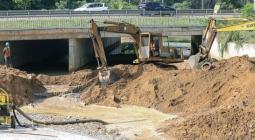Alarming Urban Expansion Pushes into Flood-Prone Areas

Urban development around the world is expanding into flood-prone areas, notably in countries facing “trade-offs between economic opportunities and disaster risk,” a new study concludes.
“Countries worldwide have been building villages, towns, and cities in flood plains faster than in areas less likely to be inundated,” writes Nature News, summarizing a study just published in the journal. This pattern bodes ill for policy-makers and communities struggling to limit the human and economic costs of the climate crisis.
“In a time when human settlements should be adapting to climate change, many countries are actually rapidly increasing their exposure to floods,” said World Bank economist and study lead Jun Rentschler. “This is a concerning trend, especially as climate change is intensifying flood disasters worldwide.”
While urban settlement overall surged between 1985 and 2015—expanding globally by 85.4% during that time—development in areas most exposed to the worst flood hazards increased by 122%.
Rentschler and his team included floods arising from torrential rain and overflowing rivers, as well as coastal flooding from storm surge and sea level rise in their calculations.
Roughly 6% of all land developed during the period of study was in the “very high” flood hazard category, which includes areas where floodwater can rise in excess of 150 centimetres (almost five feet). Another 12% was in the “high” zone, meaning that settlements there risked flooding between 50 and 150 centimetres.
The East Asia and Pacific region showed the greatest amount of development under threat from floodwaters, with “some 18.4% of all settlements” exposed to flooding.
In parts of East Asia, “high-hazard settlements have expanded 60% faster than flood-safe settlements,” the study authors wrote.
China showed the greatest acceleration in development of flood-prone areas, with the extent of settlements in the highest flood-hazard category more than tripling between 1985 and 2015.
Land scarcity is the primary driver behind the expansion into risk zones.
“Countries face trade-offs between economic opportunities and disaster risk,” Rentschler said, noting that major port cities, beachfront communities, and tourism hubs continue to expand into flood-prone coastal regions because they have nowhere else to go and remain committed to expansion.
In other cases, flood zone development may be the result of an “uninformed choice” due to inadequate flood risk assessments or urban planning regulations.
Detailed, publicly available information, policies designed to protect people, and local authorities determined to deliver the facts are all key ingredients of a solution, Rentschler and his team said. They intend to identify high-risk developments early on and publicize success stories, thus “helping to build people’s resilience to climate change”.
PHOTO: Sino-German Urbanisation Partnership/flickr




